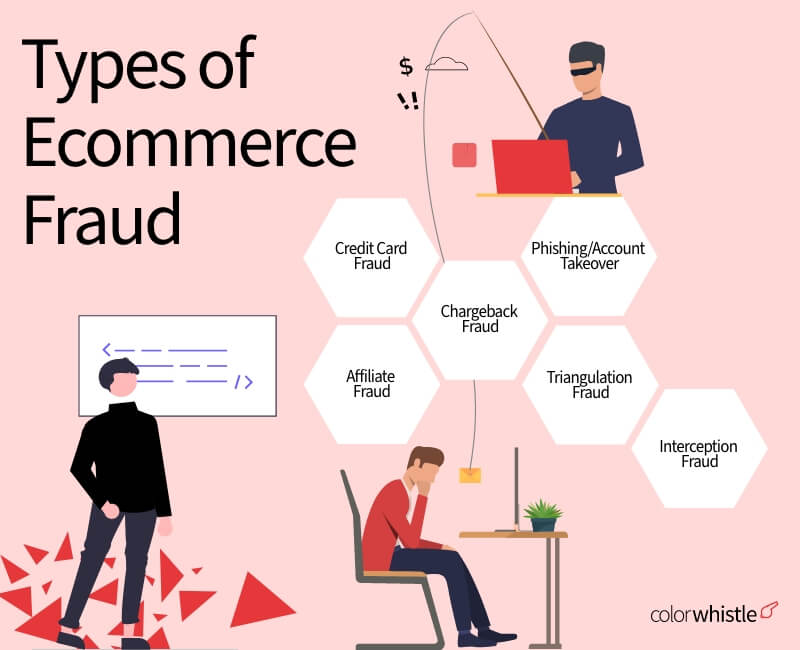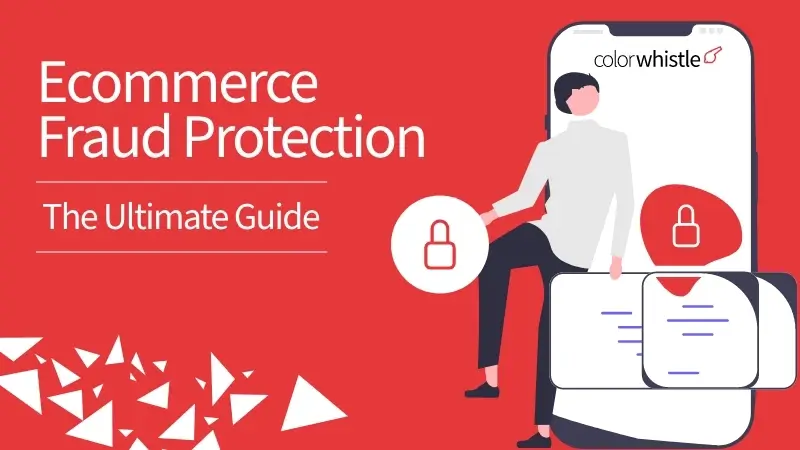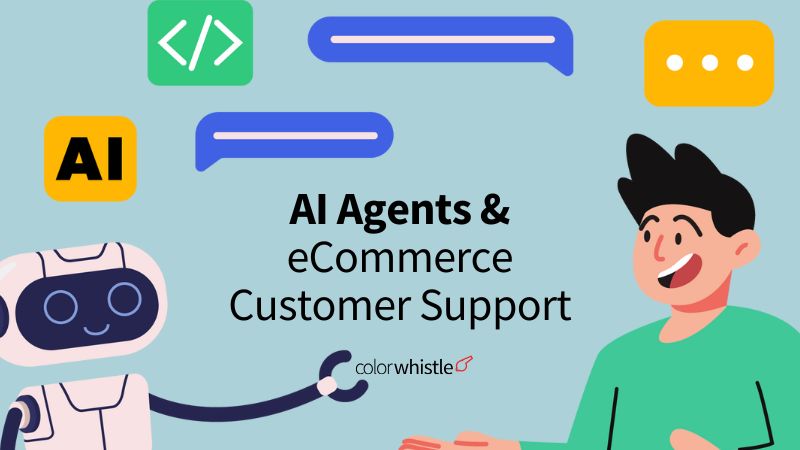The increase in the popularity of eCommerce websites, online payments has directly increased the number of online frauds that are occurring in our day-to-day life. As users find easy methods to store their sensitive personal information online, it has paved the way for fraudsters to steal and perform illegal activities. This completely affects the reputation of the business and also its relationship with customers.
Ecommerce retailers deal with an average of 206,000 web attacks per month
It’s time to know what’s happening around you. In this article, we are sharing all about eCommerce fraud—ways to detect and prevent, which might help your business to stay protected from different online frauds.
What is Ecommerce Fraud?
eCommerce fraud is a criminal deception that takes place in an eCommerce platform by a fraudster using stolen data or card details without the user’s knowledge. This is also known as purchase fraud, where the goal of the fraudster is financial gain, impacting the bottom line of the store owner.
Why Is Ecommerce Fraud Rising in 2025?
Ecommerce fraud has moved far beyond stolen cards; it’s now fueled by bots, social engineering, and fast-evolving tactics that exploit new tech. No business is immune, from small shops to global marketplaces. The damage isn’t just financial; it erodes trust, disrupts operations, and drains resources.
Did you know?
A buyer with multiple billing zip codes within a week is 30x more likely to be fraudulent.
Transactions at 2AM are 50% more likely fraudulent, while 4AM transactions are 100% more likely fraudulent
Why Does Ecommerce Fraud Take Place?
The growth of the eCommerce industry and various methods of online payments has helped in increasing the number of frauds in the digital market. Whenever new measures are implemented to prevent fraud, hackers find their smart ways to avoid the barriers.
Global payments fraud has tripled, rising from $9.84 billion in 2011 to $32.39 billion in 2020. It is projected to cost $40.62 billion in 2027—25% higher than in 2020
Reasons why fraud takes place are,
- Most of the users store their crucial information online
- The hackers can easily purchase the stolen data from the dark web
- Quite hard to detect online fraud and to trap the correct fraudulent
- It occurs across borders, making it difficult to find a legal punishment
Types of Ecommerce Fraud

1. Credit Card Fraud
Fraudsters illegally get access or obtain information from the card to make purchases, withdrawal and any fraudulent activities.
This is the most common type of eCommerce fraud. It can happen when the card number or the physical card itself is stolen.
Here, the fraudster will start with attempting smaller purchases, which would help them to determine the bounds sets for the credit card. Later, they start making big-ticket purchases before the merchant realizes that they are targeted.
How to prevent:
- Monitor your accounts regularly and report in case of any unusual activities
- Make use of chip cards as they are more secure
- In case, your card is stolen/missing, ensure to freeze your account
- Avoid saving your card details online
Also Read
2. Affiliate Fraud
Affiliate fraud is an illegal activity that is conducted to generate commission from the affiliate program. The temptation to profit urges the fraudsters to design new ways to perform illegal activities like generating new commissions or increasing the amount of commission.
Popups that appear behind the browsers were considered as unethical affiliate activity. This resulted in extending the terms and conditions for companies running affiliate program to eliminate these kinds of brand-damaging techniques.
How to prevent:
- Ensure to communicate and screen affiliates
- Regular monitoring of traffic and analytics
- Remove unethical affiliates
- Block suspicious ID addresses
- Use a fraud prevention platform
The rate of credit card chargebacks is rising 20% each year.
Also Read
3. Chargeback Fraud
Chargeback fraud can also be mentioned as “Friendly Fraud”. This occurs when a customer purchases products or services online and requests for a chargeback from the payment processor. Here, the customer gets the chargeback by claiming that the transaction was invalid.
For example, the fraudsters would purchase the product from the online store and would project that the item was not delivered. They would also inform the credit card issuer that the product has been returned, and the refund was not processed. This could also result from a legitimate purchase but, would anyway leave a negative impact on the customer and business relationship
How to prevent:
- Use strong methods for credit card verification
- Include confirmation of orders to your process flow
- Be aware of unusual orders
- Send reminders to your customers regarding the recurring payments
- Keep track of the shipments and implement signature confirmation from the customers
- Use clear product descriptions
- Define a clear return policy
4. Phishing/Account Takeover
Account takeover happens when an unauthorized person gains access to a user’s account, either through an eCommerce store or website. This can be achieved using various methods like purchasing stolen passwords. Obtaining customers’ personal information from the web or by implementing phishing schemes against customers.
Once the fraudsters have gained the access, they try to change the customer’s account details, make purchases, withdrawals, and access all other accounts owned by the user.
How to prevent:
- Check your user’s database regularly
- Limit the number of login attempts
- Send notification to your users if their account has been compromised
5. Interception Fraud
In the interception fraud, the fraudster completes his purchase with a stolen credit card along with legitimate shipping and billing address. Here, the fraudster’s goal is to intercept the package before it is delivered to the provided address.
The common tricks that these fraudsters implement to intercept the package are,
- If they live near to the victim, they wait until the package is delivered physically
- Contact your company’s customer service and request for the change in shipping address
- Contact the shipping guys to reroute and change the delivery destination
How to prevent:
- Secure your credit card details
- Secure your users’ database
- Use SSL certificate to your website
- Usage of secure and strong credentials
6. Triangulation Fraud
This fraud includes three members: the fraudster, the customer and the eCommerce store. Here, the fraudster would set up a fake store that looks like it is selling high-demand products.
The store would bring in more legitimate customers who would make their purchases from the fraudster’s website. The fraudster would buy products from your eCommerce store using a stolen credit card and send the goods to their customers. The one who lost the credit card and your eCommerce store are the victims.
How to prevent:
- Keep an eye on the new accounts created on your website, especially if they purchase frequently
- Start suspecting if the shipping and billing address are not the same
- Verify your customers’ contact details
AI, Bots, and Sophisticated Fraud Tactics
Fraudsters now use advanced tools that rival business security systems.
- AI Attacks: Fake identities, targeted phishing, and shopper-like behavior slip past detection
- Bots: Test stolen logins, exploit promos, hoard inventory, and mimic real browsing patterns
- Deepfakes & Voice Spoofing: Synthetic media tricks verification and support teams
- Social Engineering: Scammers leverage leaked data and public info to impersonate customers
Promo Abuse
Fraudsters exploit discounts, sign-up bonuses, and referral programs by creating fake accounts, stacking codes, or self-referring for rewards.
How to prevent:
Verify signups, set strict promo rules, limit usage, and monitor suspicious activity.
Also Read
How to Identify Ecommerce Fraud Online
In this digital world, consumers aren’t the only one’s at risk. Businesses are also affected due to the online fraud that keeps recurring every day. It is a prime necessity to identify how the fraud happens? Whom are these fraudsters targeting?
Below, are some of the alerts that would help in identifying whether the transaction is fraudulent or not,
- When customers purchase in large quantities than average order
- When the customer purchases from unusual locations
- A single customer having multiple shipping addresses
- When more number of transactions happen in a short period of time
- Multiple orders using multiple credit cards
- Multiple declined transactions
- Strings of orders from a new country
Did you know?
Fraudsters dislike capital letters. If a customer wrote their billing name in all lowercase letters, the order is 2.7x more suspicious
An email address with two or more digits is twice as likely to be fraud than one with zero or one digit.
Steps for Preventing Fraud on Your Ecommerce Website
It’s essential to incorporate a comprehensive eCommerce store maintenance checklist to ensure your store remains secure and efficient.
Below are some of the steps that you can initiate to prevent your eCommerce store from fraudsters,
- Ensure to conduct site audits on regular basis – plugin updates, SSL certificate, PCI-DSS complaint, usage of strong passwords, encrypting communications and removal of unused plugins
- Make sure your business meets PCI standards
- Monitor your store regularly to identify any red flags/suspicious activity like inconsistent billing and shipping addresses
- Used AVS (Address Verification Services) and CVV (Card Verification Value) for all purchases
- Use HTTPs to encrypt all the sensitive information at your store
- Use fraud detection and management software which would help in detecting high-risk transactions.
- Set limits on purchases
- Verify whether the IP address and the credit card address matches
- Avoid shipping to post office boxes or any virtual addresses
- Secure your email domain with SPF, DKIM and DMARC protocols and never click on suspicious links in emails.
SSL Certificate
SSL – Secure Socket Layer, this helps in authenticating the website’s identity by enabling encrypted links between the web browser and server. A website with an SSL certificate is considered to be safe and secure. When you fail to configure this certificate, customers/ visitors would hesitate to visit your website, affecting the reputation of your business.
PCI DSS
It stands for Payment Card Industry Data Security Standard, and was launched by PCI SCC. This was introduced with the intention that companies who accept, process, store or transmit credit/debit card information must adhere to this compliance in order to create a secure environment.
How Does Ecommerce Fraud Impact Merchants?
- Financial Losses: Stolen goods, chargeback fees, and recovery costs can hit cash flow hard
- Reputation Damage: Breaches erode trust, spark bad reviews, and reduce customer loyalty
- Operational Strain: Teams waste time on disputes and fixes instead of growth
- Regulatory Risks: Non-compliance with GDPR, CCPA, and other rules can trigger fines and legal trouble
Next-Gen Approaches to eCommerce Security
AI & ML for Fraud Prevention
In 2025, eCommerce security depends on more than firewalls; it needs intelligence. Artificial intelligence (AI) and machine learning (ML) analyze massive transaction data in real-time, flagging suspicious behavior before damage occurs.
- Smarter Detection: Tools like Kount and Sift Science catch anomalies instantly
- Predictive Power: Algorithms spot hidden trends, warning you about risky purchases or devices
- Adaptive Defense: ML learns from every transaction, evolving with fraud tactics
- Frictionless Checkout: Security runs in the background, protecting customers without slowing them down
AI and ML deliver sharper accuracy, fewer false positives, and stronger customer trust, making them essential weapons against digital fraud.
Predictive Analytics
With advanced tools like those from Kount or Sift, businesses can now anticipate which orders are likely to be risky long before any harm is done. These models crunch data to flag anomalies instantly, helping stores strike a balance between seamless shopping and tight security.
Biometric Authentication
Fingerprint scans, facial recognition, and even voice authentication are becoming more common, especially as mobile shopping surges. Apple Face ID and Android’s biometric logins mean users can prove their identity with a glance or a word, low effort, high security.
Blockchain Technology
The buzz isn’t just hype; blockchain adds a powerful layer of transparency and security. Each transaction is recorded in a tamper-proof ledger, making it tough for anyone to fudge the numbers or manipulate data mid-flight. This creates an auditable paper trail and makes dispute resolution a far smoother process.
Seamless Customer Experience
The latest fraud prevention tools work quietly in the background so that your customers enjoy quick, hassle-free checkouts, with no need for multiple forms or endless password resets.
Multi-Factor Authentication (MFA)
MFA adds a second layer of security, like a password plus a smartphone code, making stolen credentials useless. Widely used by Google, Amazon, and banks, it sharply reduces unauthorized access.
Chargeback Protection Solutions
Platforms like Stripe, PayPal, and Shopify offer chargeback protection to reduce revenue loss from fraudulent claims. These services manage disputes, automate reviews, and may cover eligible losses, saving time for support teams and minimizing disruptions. With safeguards in place, merchants can focus on growth instead of costly fraud fallout.
Tokenization for Data Protection
Tokenization replaces card details with random tokens, keeping real data off your systems. Even in a breach, stolen tokens are useless. Platforms like Stripe and PayPal use it as standard protection.
Adopt Secure Payment Gateways
Gateways like Authorize.net and Braintree encrypt payment data and send it directly to banks. This reduces exposure risks and ensures compliance with PCI DSS.
Looking for eCommerce Development Services?
Seize and experience the transformative impact of eCommerce Development Services & Solutions with ColorWhistle.
How to Choose the Right Ecommerce Fraud Prevention Solution
The best tool depends on your business model, risks, and growth plans. Keep these factors in mind:
- Know Your Risk Profile: Identify fraud types most likely to hit your store, high volumes, global sales, or specific product risks
- Match Features to Needs: Look for real-time detection, machine learning, customizable rules, and checks like AVS/CVV
- Integration & Scalability: Ensure it works smoothly with Shopify, WooCommerce, Magento, or your stack, and can grow with you
- Balance Security & CX: Stop fraud without blocking legitimate customers or slowing checkout
- Check Reviews & Validation: Compare platforms like Riskified, Signifyd, and Kount using real user feedback and case studies
- Analyze ROI and Total Cost of Ownership (TCO): Evaluate pricing, fraud reduction, time savings, and long-term benefits to ensure your fraud prevention solution delivers real value.
This ensures your investment delivers measurable protection and ROI.
It’s time to take action
Establishing an eCommerce store would help in the global reach. But, at the same time, you must ensure that your store as well as your potential customers are safe and secure.
Yes, fraudsters are intelligent and work out of the box for achieving their goals. Businesses of any size can become a prey to the cyberattacks as they are recurring every day. Ensure to understand what eCommerce fraud is? And ways to prevent it. This awareness and steps to avoid it would help you to run a safe and secure online business and also gain trust from your potential customers. Likewise, always ensure to build your eCommerce website adhering to its security regulations.
Want to establish a safe and secure eCommerce website for your business?
Contact ColorWhistle by sending us a message or call us at +1 (210) 787-3600, we’ll get back to you at the earliest. We provide services tailored to your requirements that suit your business model.
In quest of the Perfect eCommerce Development Services & Solutions Buddy?
Be unrestricted to click the other trendy writes under this title that suits your needs the best!
- 3D Product Configurators & Augmented Reality: Elevating Your Furniture Brand Online and Offline
- Creating a Jewelry Website – Here are 15+ Factors to Consider for eCommerce Jewelry Website
- Top Business Models that Works for Online eCommerce Websites
- Insights on Global e-Commerce Trends from a Digital Agency Perspective
- Top Beauty & Lifestyle E-commerce Websites – A Tech Audit
- E-commerce Websites of Top Luxury Fashion Brands
- Top Grocery E-commerce Websites – A Tech Audit
What’s Next?
Now that you’ve had the chance to explore our blog, it’s time to take the next step and see what opportunities await!





